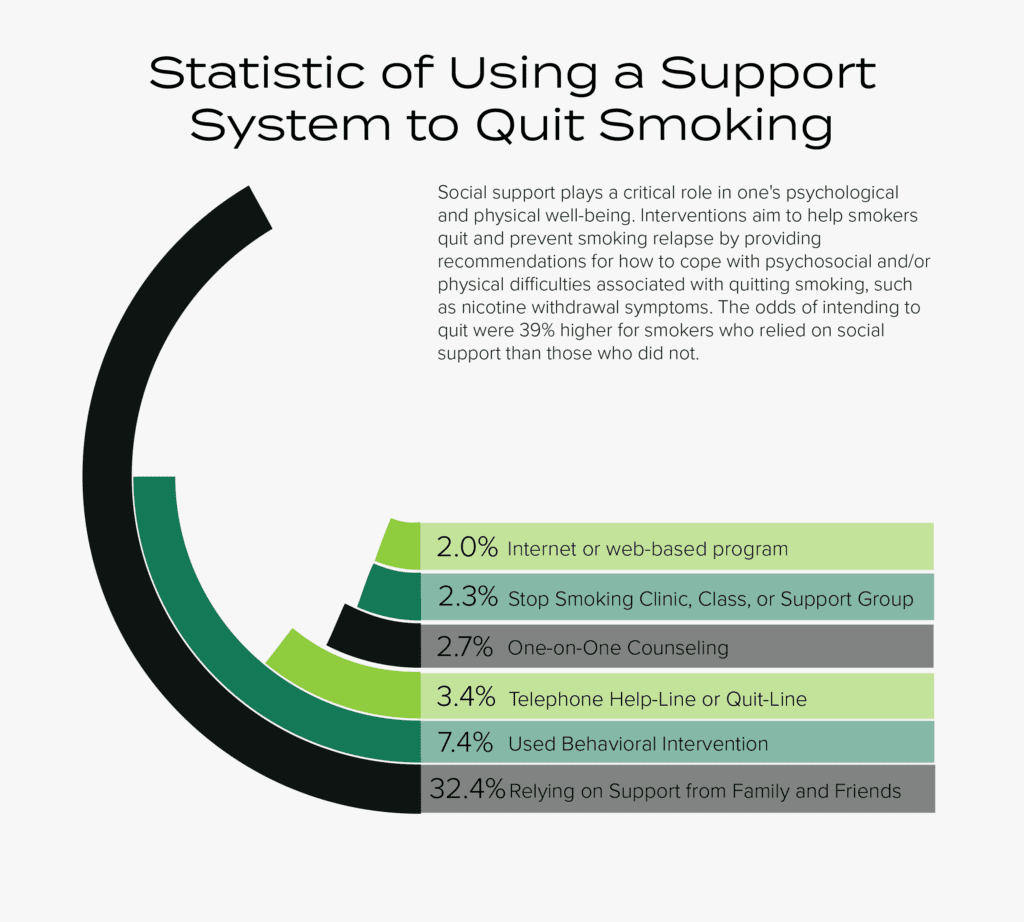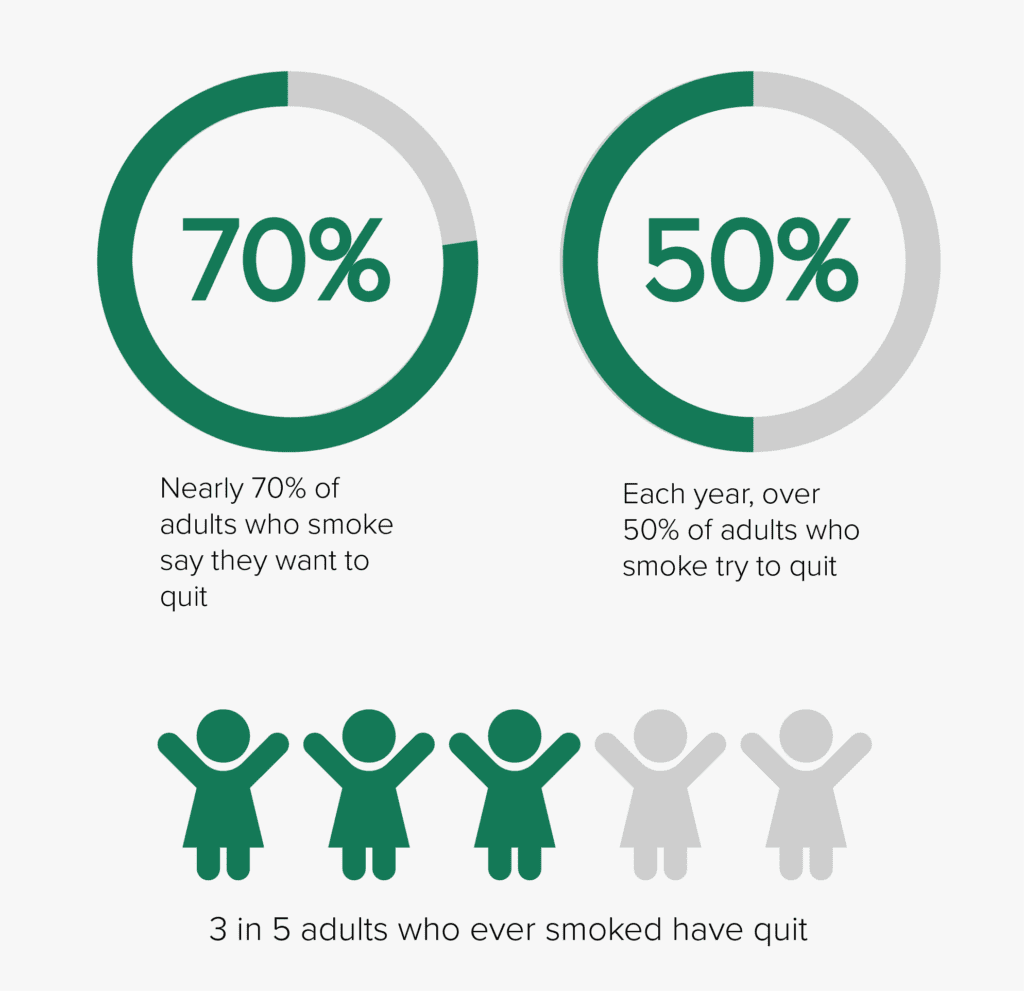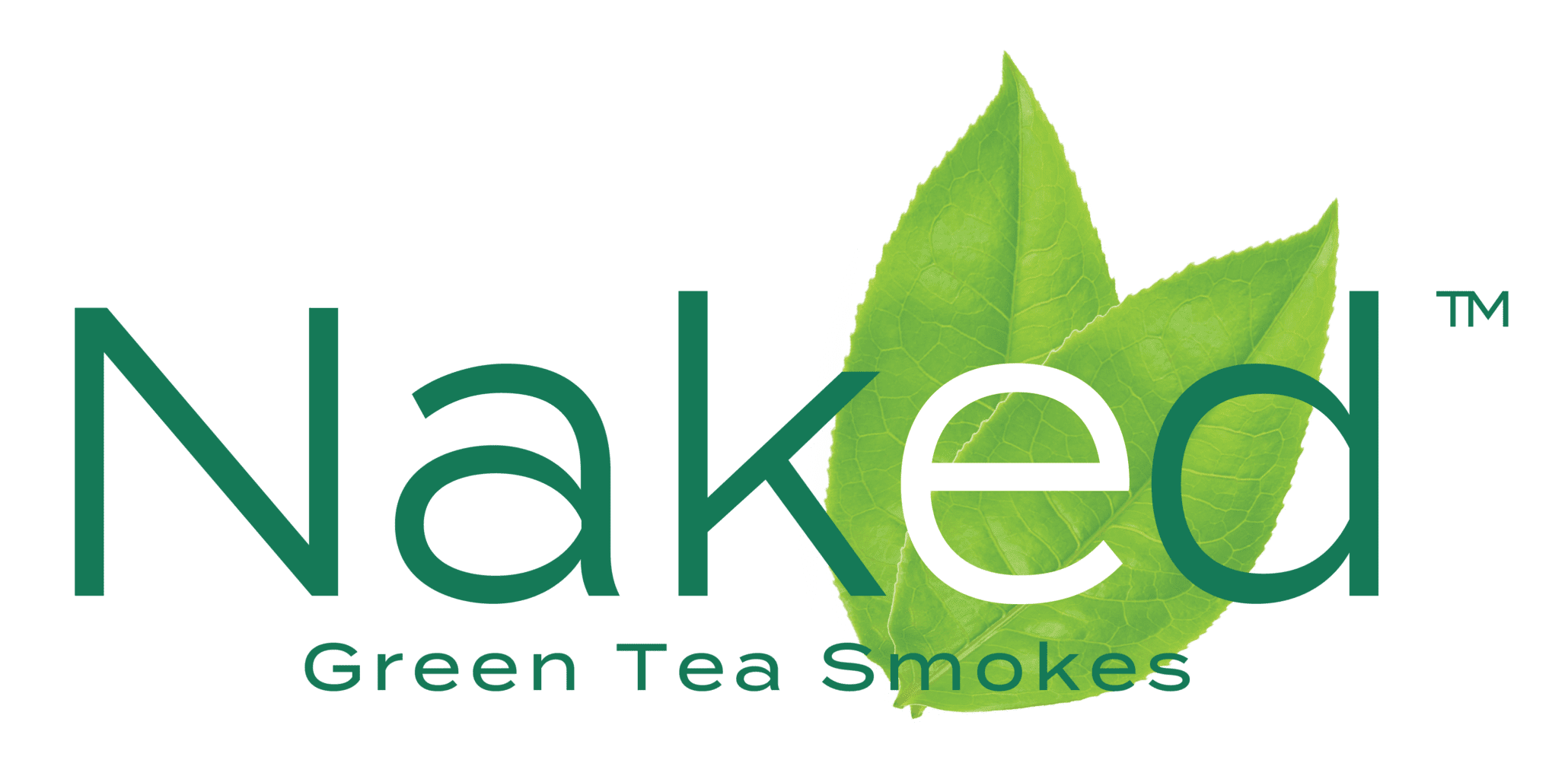Although most smokers want to quit, finding an alternative that makes quitting easier and less painful is a challenge to many. However, quitting smoking can increase your life’s quality. However, experts say that many people have failed after many attempts. Fortunately, smart alternatives such as the non addictive, Naked Smokes can help smokers quit addictive tobacco for good. Our guide highlights six steps that can help increase the odds of success. Follow the steps for easier and less painful ways to stop smoking and nicotine delivery devices.
Step 1 — Know Why You Want to Quit
The first step to successfully quitting smoking is to know why you want to stop. Having a personal reason can motivate you, especially when dealing with nicotine withdrawal side effects. It can prove difficult to deal with sleep disturbances, irritability, anxiety, and depression without a powerful reason to quit. The top reasons why smokers want to quit include the following:
- Protecting Family Members
We encourage people to stop smoking to avoid the dangers of second-hand smoke and other associated health risks. Exposing adults to second-hand smoke can cause immediate harmful effects on their blood vessels and their heart. Besides interfering with the vascular system’s normal functioning, exposure to second-hand smoke increase the risk of stroke, heart disease, and reproductive health effects. Protect your children from the immediate and long-term effects of exposure to second-hand smoke. Experts link second-hand smoke to sudden infant death syndrome, asthma attacks, respiratory infections, and ear infections among children.
- The Desire for a Better Life
Going smoke-free has tremendous health benefits. In the short-term, your circulation and blood functions improve as your body’s carbon monoxide levels normalize. Your senses of taste and smell improve within the first day of your last smoke. The rate of the smoker’s cough decreases over time. In the long-term, the chances of dying from smoking-related diseases such as cardiovascular disease falls. Quit smoking to reduce the risk of certain types of smoking-related cancers, including throat, mouth, esophagus, and larynx. The earlier you can quit, the better. You can add up to 10 years to your life and significantly reduce the risk of smoking-related diseases.
Nicotine smoking is very addictive. Therefore, we encourage you to find a strong reason that will help you fight the urge to light up if you want to quit smoking.
Step 2—Build a Support System for Accountability

Although you can successfully quit smoking through self-commitment, getting support will make it easier to stay on track. Walking the journey on your own could become a challenge if you do not have the willpower to resist the urge to light a cigarette. You can always ask for help. Build a support system that can improve your accountability. Many stop-smoking support programs offer telephone call support, online support, and one-on-one in-person support. Your support system can include the following:
- Support from Family and Friends
Supportive family members and friends can help a person quit smoking. Having a close family member you talk to during your quit attempt is important. You can start with one member and build on as the process continues. However, ensure that your loved ones understand what you are going through for them to help you. Explain to them the benefits and side effects of your quitting methods, such as non addictive alternatives by Naked Smokes, for them to understand how they will be helpful. Family members and close friends are the closest people to regularly check in and remind you to stick to your routine or lend an ear whenever you want someone to listen. Besides, they can help you from relapsing by distracting you with activities such as weekend movie outs.
- Online Support Programs
You can also get the support you need to stay on track from online support programs. A good example of such programs where you can find helpful resources include the Freedom From Smoking program by the American Lung Association.
- Talk to A Counselor
You can get the support and tools to help you cope with cravings and withdrawal setbacks by talking to a counselor. Although you be using non addictive alternatives, you will need coping mechanisms to help you set off the urges, identify triggers, and adapt to behavior changes.
Step 3 —Explore Your Options
Consider alternative treatment options to find that will help you quit smoking. It is important to remember that there is no one-size-fit treatment for everyone. The common medication in the market that help people manage their nicotine dependency and cravings include the following:
- Nicotine Replacement Therapies: They include patches that help reduce your nicotine cravings. They work by giving the body nicotine, but in small amounts to help you manage withdrawal symptoms. Some people find it easier to quit smoking with nicotine replacement therapy. However, this option works best when combined with other prescriptions. That usually means combining one treatment with over-the-counter medication to help with cravings when quitting smoking. Other forms of nicotine replacements that act in the short term can be used alone regularly to help with nicotine cravings.
- Varenicline (Chantix): This treatment option has recorded high quit rates. It works by blocking nicotine receptors to reduce withdrawal symptoms. It binds to the nicotine receptors to make smoking less pleasurable to smokers. This prescription medication has side effects such as adverse effects, including changes in libido and increased depression. Although the FDA approves it, consult your doctor before you use Varenicline treatment.
- Bupropion: This option is another FDA-approved treatment option that works by sending nicotine receptors into a catatonic state. Besides, it helps minimize the risk of initial weight gain when quitting smoking. In the long term, Bupropion prevents relapses. Use it with a non addictive combination or other treatment options such as Vareniclines for better results. However, it has adverse effects on people with seizure disorders. Therefore, consult your doctor before adopting Bupropion as your treatment option.
- Smart Alternatives (Naked Smokes): You can try Non addictive, Naked Smokes as a smart alternative that interrupts nicotine cravings for anyone quitting addictive tobacco. Naked Green Tea Smokes give the users caffeine-generated energy analogous to nicotine. This non addictive product is free of tobacco, nicotine, and chemical additives.
Step 4 —Learn Your Triggers and How to Handle Cravings
Besides using non addictive alternatives, your first defense line in quitting smoking is to know common triggers. You can begin adjusting and changing your routine once you understand your triggers. Such changes will help you avoid the situation that triggers your cravings. The common triggers you should watch out for include the following:
- Emotional triggers
Intense emotions can easily trigger most people’s cravings. Emotions such as stress remind smokers of escaping their current moods after a smoke. Most smokers get the intense urge to smoke when stressed, excited, lonely, bored, or anxious. The best way to handle emotional triggers is to participate in relaxing exercises. You can call anyone within your support system to help you relax. Other activities that can help you distance yourself from emotional triggers include walking or running outside or trying deep-breathing exercises that help you relax. Besides, you can find calming music to help you slow your heartbeat and decrease your stress hormones. Your loved ones can help by reminding you that smoking is not a coping mechanism for unpleasant feelings.
- Patterns Triggers
Smokers often have a routine. For example, you may realize that you smoke with the same people at a specific place or time over and over. Once you discover the activities that link you to smoking, you should begin changing your routine to handle your cravings. The most common pattern triggers include driving, watching TV, drinking alcohol, drinking coffee, and taking a work break. Complement your non addictive alternatives, such as Naked Green Tea Smokes, by breaking your association with the common pattern triggers.
- Social triggers
Common social triggers include occasions that involve association with other smokers. You should avoid going to the bar, attending concerts, attending social parties or events, or being around friends who smoke once you decide to quit. Always avoid friends who smoke or places where you will likely find smokers.
- Withdrawal triggers
Common withdrawal triggers, such as the urge to hold lighters and cigarettes in the hands, will trigger nicotine cravings. The body is often used to getting nicotine and can feel restless during withdrawal. Participate in activities that distract your mind from nicotine cravings.
Step 5—Learn How to Handle Nicotine Withdrawal

Anyone who has used tobacco products for a long time will likely experience nicotine withdrawal symptoms. Nicotine, the highly addictive substance that creates dependency, always needs to be maintained at a certain level. Unless you chew tobacco or smoke to maintain the level, you may begin to experience withdrawal symptoms. People that quit smoking experience short-lived but uncomfortable withdrawal symptoms. This period is when smart alternatives such as Naked Green Tea Smokes help people trying to quit smoking. The Non addictive, Naked Smokes help reduce the unpleasant feeling during withdrawal.
Nicotine withdrawal can be a tough journey you must prepare for in advance before quitting. You must prepare yourself and your loved ones to handle the following mental, behavioral, physical, and emotional withdrawal symptoms:
- Increased food appetite: Your appetite will increase once you quit smoking. Most people eat a lot during this phase as a stress-coping mechanism. However, the body may not burn calories as fast, leading to a possibility of weight gain.
- Anxiety: Expect mood changes after quitting smoking, especially if you have a history of depression or anxiety. Although you may feel that smoking helped you with your anxiety and depression, do not be tempted to smoke again. Instead of returning to nicotine dependency, you can stay active or connect with people to help you cope.
- Insomnia: Having trouble sleeping is a common nicotine-withdrawal symptom. Instead, incorporate physical activities or non addictive alternatives into your routines to help your sleep.
- Irritability: You will notice that anyone in the withdrawal phase feels irritated or moody. Inform the people around you that this is a common symptom for them to support you during this phase.
- Restlessness: It is common for anyone withdrawing from smoking to experience restlessness for the first few days or weeks. Participating in physical activities can help manage this jumpiness.
- Nicotine cravings: The urge to smoke again is common for anyone who quits smoking. The urges are overwhelming if you do not have a strong will to resist. Avoid common withdrawal triggers to help you handle the cravings.
Step 6—Enjoy the Freedom of Being Addiction Free
Approximately 18% of Americans admit to smoking at a certain point in their lives. And at least 70% of these smokers admit attempting smoking cessation. It is understandable for these people to try to quit smoking due to its link to chronic obstructive pulmonary disease (COPD), lung cancer, and gum disease. Besides contributing to 1 in 5 preventable deaths, smoking cigarettes increases the likelihood of getting diabetes, difficulty with erections, osteoporosis, and problems in pregnancy. Unfortunately, a nicotine-dependent’s life is exposed to these risks every minute they continue smoking. Every day is all about avoiding withdrawals, seeking tobacco products, or finding a way to treat preventable diseases.
There is little freedom in an addict’s life. There is a risk of harming themselves or posing a threat to others every minute they smoke. However, the lucky smoker that quit successfully finds freedom. Consider recovery from nicotine dependency with freedom. You will enjoy freedom once you embrace non addictive alternatives such as Naked Green Tea Smokes. Such smart alternatives help you end the cycle of getting, using, and finding means to get more cigarettes. Freedom from addiction means the following:
- Healthier Relationships
Your relations with the people around you improve once you become addiction free. Most support programs include teachings on reconstructing relationships after withdrawal.
- Enhanced Work Ethics
Addiction-free individuals often have more to offer to themselves and their employers. Non addictive alternatives can help you quit smoking, leaving you with the energy and focus on achieving your goals.
- More Energy to Achieve Daily Goals
Addiction-free individuals have more energy throughout the day than before. Once the body is nicotine-free, they spend less energy worrying about life. Instead, they refocus their energy on adopting positive perspectives on life. Such individuals have a better structure and a healthy routine with set goals. Having more energy and a daily structure helps non-addicts enjoy a life of goals with more confidence and focus.
On the Bottom Line
Knowing what triggers your cigarette cravings can help you avoid the temptation to light one. Common triggers may include boredom or stress. However, these triggers are unique to different people. They also include smelling cigarette smoke, attending parties, or watching someone else smoke. Unfortunately, most people who have been hooked to smoking for a long-time struggle with withdrawal triggers. Besides avoiding your triggers, Naked Green Tea Smokes is a smart alternative you can choose to help you quit addictive tobacco. Non addictive, Naked Smokes provide smooth draws analogous to tobacco cigarettes. Naked’s alternative will give you the gratification of smoking while helping you quit tobacco and nicotine delivery devices. Start your journey to an addiction-free life today!

